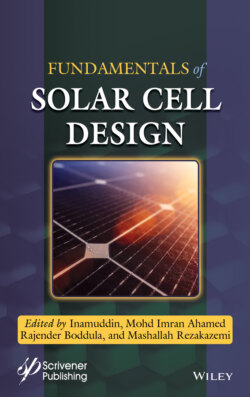Читать книгу Fundamentals of Solar Cell Design - Rajender Boddula - Страница 53
3.1 Introduction
ОглавлениеThe increasing population and its energy consumption are demanding huge energy and create the energy crisis. To fulfil the energy need, increase in power production using conventional resources produces the greenhouse gases which disrupt the climate change [1]. Currently, 80% of energy is prepared by non-renewable resources worldwide. The conversion of resources to energy generate massive CO2 emissions, which increases the temperature of the earth and melts the polar ice as result rise in sea level [2]. To understand the energy crisis and problem created by greenhouse gases, the scientist is taking much interest in alternative renewable energy sources.
The sunlight is the huge source of renewable energy and scientist is doing enormous research on photovoltaic (PV) technology. Today, scientist reaches up to third generation of solar cell, namely, tandem solar cell (TSC). The world-wide PV market has more than doubled in 2010, and the market nurtures again by almost 30% in 2011 [3].
Tandem cell construction presents a lane toward superior module efficiencies over single-junction design owing to the capability to divide the solar spectrum into multiple bands [4]. The simplest structure where two absorbers are stacked is the so called tandem. The stacked layer presents in tandem of different bandgap materials. When the sunlight falls on the tandem cell, the high energy light absorb by the material has high bandgap and the low energy light is secondly absorb with the lower bandgap [5].
In tandem devices, the intermediary layer is the critical processing steps, building an ohmic contact among the two sub-cells [6]. The TSC has two, three and four junction and efficiency reached upto 32.8%, 44.4%, and 46.0%, respectively. The multi junction device modelling evaluation is near approaches of the scientists. There are various types of TSC that can be differentiating on the basis of the material used in the cell. The organic tandem solar cell (OTSC) [7–12] is most suitable and economic but it has low efficiency upto 15%. The inorganic tandem solar cell (ITSC) [13–17] has very expensive and high efficiency upto 46% and used in space applications. The hybrid tandem solar cell (HTSC) [18–24] is the third type and Perovskite tandem has already proven to be quite efficient (17%) and low cost, mostly because of cheap materials that are being used.
